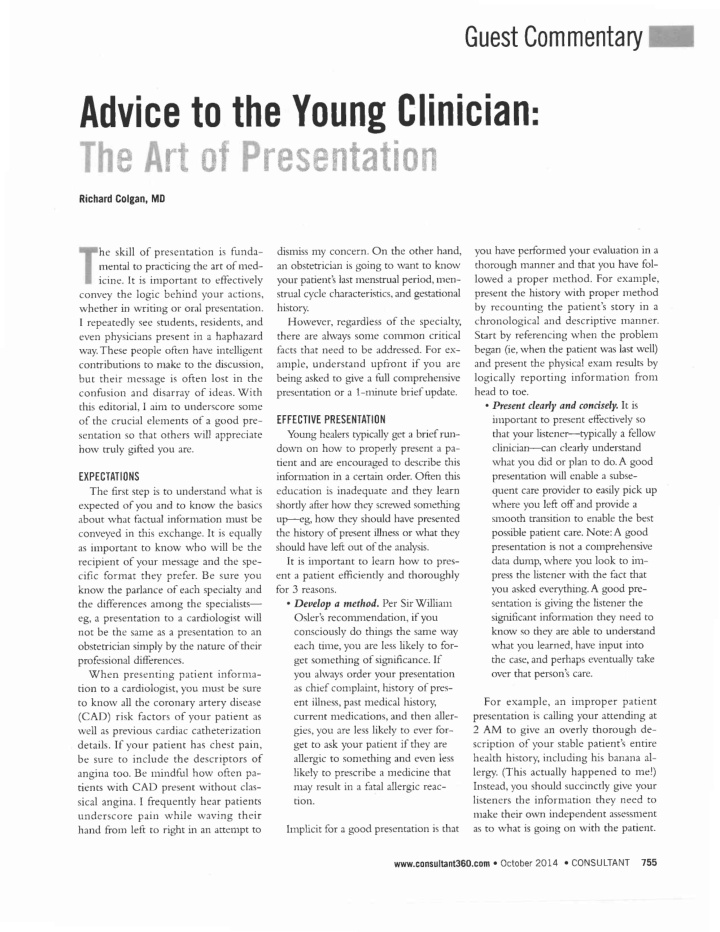



Guest Commentary I Advice to the Young Clinician: Thm Ar& m$ Prffismm&mt&mrx Richard Colgan, MD you have performed your evaluation in a he skill of presentation is funda- dismiss my concern. On the other hand, thorough manner and that you have fol- an obstetrician is going to want to know mental to practicing the art of med- lowed a proper nrethod. For exaurple, icine. It is important to effectively your patienti last menstrual period, men- present the history with proper rnethod convcy the logic behind your rctions, strual cycle characteristics, and gestarional by recounting the patient's story in a whether in writing or oral presentation. history. I repeatedly see stndents, residents, and Horvever, regardless of the specialty, chronologic.rl .rnd descriptive tnanner. even physicians present in a haphazard Start by referencing when the problen-r there are alrvays sonre colnnlon critical began (ie, when the patient was last weil) r,vay. These people often have intelligent facts that need to be addressed. For ex- ample, understand upfr-ont if you are and present the physical exam results by contributions to make to the discussion, but their nlessage is often lost in rhe logically reportir.rg information from being asked to give a full comprehensive confusion ar.rd disarray of ideas. Wich head to toe. prescntation or a 1-nrinute briefupdate. . Prcsent clearly ad concisely,lt rs this editorial, I ainr to underscore some important to present effectively so of the crucial eler.nents of a good pre- EFFECTIVE PRESENTAII(]N sen[ation so that others will apprer:iate Young hcalers rypically get a briefrun- that your listener-rypically a fellow dor,vn on how to properly present a pa- clinician-can clearly understand horv rruly gil'ted you are. what you did or plan to do. A good tient and are encourased to describe this presentation will enable a subse- infornration in a certain order. Often this E)(PECTATIONS quent care provider to easily pick up The first step is to understand what is education is inadequate and they learn expected ofyou and to know the basics where you left offand provide a shordy after how they screwed something about r'vhat factual infornration rlust be up-eg, horv they should have presented smooth transition to enable the best conveyed in this exchange. It is eqr,rally the history of present illness or what they possible patient care. Note:A good as important to kuow who rvill be the presentation is not a cornprehensive should have left out of the analysis. It is irnportant to learn how to pres- data dump,'uvhere you look to im- recipient of your lllessagc and rhe spe- press the listener with the facr that cific format they prefer. Be sure you ent a patienr efTiciently and thoroughly for 3 reasons. you asked everything. A good pre- knor.v the parlance of each specialty and . Deuelop a methoil. Per SirWilliam che differences among the specialists- sentation is giving the listener the eg, a presentation to a cardiologist rvill Oslert recommendation, if you significant information they need to nor be thc same as a presentation to an consciously do things the same way know so chey are able to understand each tirne, you are less likely to for- what you learned. have input into obsterrician simply by the nature of their get something of significance. If the case, and perhaps eventually take proGssional differences. When presenting patient informa- you alrvays order your presentation over that personi care. tion to a cardiologist, you rnLrst be sure as chief cornplaint, history of pres- For example, an improper patient to knorv all the coronary artery disease ent illness, past medical history, (CAD) risk factors of your patient ls current medications, and then aller- presentation is calling your atrending at 2 AM to give an overly thorough de- gies, you are less likely to ever for- rvell as previous cardiac catheterization details. Ifyour patient has chest pain, get to ask your patient ifthey are scription of your stable patientt entire be sure ro include the descriptors of health history, including his banana al- allergic to sonrething and even less lergy. (This actually happened to me!) angina too. Be mindful how often pa- likely co prescribe a medicine that nray result in a fatal allergic reac- Inscead, you should succincrly give your tiencs wich CAD present without clas- sical angina. I frequently hear patients listeners the information they need to tion. underscore pain while waving their make their orvn independent assessment as to rvhat is going on with the patient. hand from left to right in an attempt to Implicit for a good presenration is that www.consultant360.com . October 2Ol4 . CONSULTANT 755
Recommend
More recommend